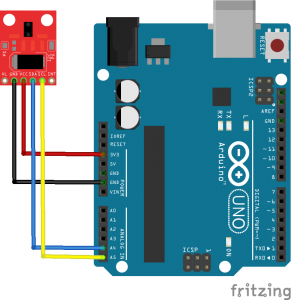AED 30.45
Description
This is CJMCU 9930 APDS-9930 Digital Proximity And Ambient Light Sensor. The APDS-9930 provides digital ambient light sensing (ALS), IR LED, and a complete proximity detection system in a single 8-pin package. The proximity function offers plug-and-play detection to 100 mm (without front glass) thus eliminating the need for factory calibration of the end equipment or sub-assembly.
The proximity detection operates well in bright sunlight to dark rooms. The wide dynamic range also allows for operation in short-distance detection behind dark glass such as a cell phone.
In addition, an internal state machine provides the ability to put the device into a low power mode in between ALS and proximity measurements providing very low average power consumption. The ALS provides a photopic response to light intensity in very low light conditions or behind a dark faceplate.
Specifications:
• Ambient Light Sensing (ALS)
- Approximate human visual response
- Programmable interrupt capability with upper and lower thresholds
- Up to 16-bit resolution
- High sensitivity operation behind dark glass
- 0.01lux low lumen performance
• Proximity detection
- Fully calibrated to 100 mm detection
- Integrated infrared LED and synchronous LED driver
- Eliminates factory calibration of the proximity sensor
• Programmable wait timer
- Wait state power consumption - 90μA typical
- Programmable range from 2.7 ms to more than 8 seconds
• I2C interface compatible
- Up to 400kHz (I2C fast mode)
- Dedicated interrupt pin
• Sleep Mode Power - 2.2μA typical
• Small package 3.94 (L) x 2.36 (W) x 1.35 (H) mm
Applications:
• Adjustable light mobile phone backlight
• Notebook / display security
• automatically enabled hands-free mode
• Automatic menu popup
• Digital camera eye sensor
Pinout of the module:
| Pin Label | Description |
|---|---|
| VL | Optional power to the IR LED. Must be 3.0 – 4.5V |
| GND | Ground. |
| VCC | Must be 2.4 – 3.6V |
| SDA | I2C data |
| SCL | I2C clock |
| INT | External interrupt pin. |
Code
You need to install the following library – https://github.com/Davideddu/APDS9930 . This is an ambient light example, there are also proximity examples
We also recommend you take a look at the sparkfun library – https://github.com/sparkfun/APDS-9960_RGB_and_Gesture_Sensor/ and take a look at those examples as well

#define DUMP_REGS
#include "Wire.h"
#include "APDS9930.h"
// Global Variables
APDS9930 apds = APDS9930();
float ambient_light = 0; // can also be an unsigned long
uint16_t ch0 = 0;
uint16_t ch1 = 1;
void setup()
{
// Initialize Serial port
Serial.begin(9600);
Serial.println();
// Initialize APDS-9930 (configure I2C and initial values)
if ( apds.init() )
{
Serial.println(F("APDS-9930 initialization complete"));
}
else
{
Serial.println(F("Something went wrong during APDS-9930 init!"));
}
// Start running the APDS-9930 light sensor (no interrupts)
if ( apds.enableLightSensor(false) )
{
Serial.println(F("Light sensor is now running"));
}
else
{
Serial.println(F("Something went wrong during light sensor init!"));
}
// Wait for initialization and calibration to finish
delay(500);
}
void loop()
{
// Read the light levels (ambient, red, green, blue)
if ( !apds.readAmbientLightLux(ambient_light) ||
!apds.readCh0Light(ch0) ||
!apds.readCh1Light(ch1) ) {
Serial.println(F("Error reading light values"));
}
else
{
Serial.print(F("Ambient: "));
Serial.print(ambient_light);
Serial.print(F(" Ch0: "));
Serial.print(ch0);
Serial.print(F(" Ch1: "));
Serial.println(ch1);
}
// Wait 1 second before next reading
delay(1000);
}